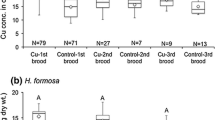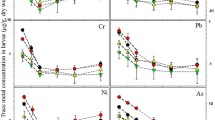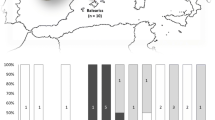Abstract
The maternal transfer of trace elements is a process by which offspring may accumulate trace elements from their maternal parent. Although maternal transfer has been assessed in many vertebrates, there is little understanding of this process in invertebrate species. This study investigated the maternal transfer of 13 trace elements (Ag, As, Cd, Co, Cr, Cu, Fe, Hg, Mn, Ni, Pb, Se, and Zn) in Atlantic horseshoe crab (Limulus polyphemus) eggs and compared concentrations to those in adult leg and gill tissue. For the majority of individuals, all trace elements were transferred, with the exception of Cr, from the female to the eggs. The greatest concentrations on average transferred to egg tissue were Zn (140 µg/g), Cu (47.8 µg/g), and Fe (38.6 µg/g) for essential elements and As (10.9 µg/g) and Ag (1.23 µg/g) for nonessential elements. For elements that were maternally transferred, correlation analyses were run to assess if the concentration in the eggs were similar to that of adult tissue that is completely internalized (leg) or a boundary to the external environment (gill). Positive correlations between egg and leg tissue were found for As, Hg, Se, Mn, Pb, and Ni. Mercury, Mn, Ni, and Se were the only elements correlated between egg and gill tissue. Although, many trace elements were in low concentration in the eggs, we speculate that the higher transfer of essential elements is related to their potential benefit during early development versus nonessential trace elements, which are known to be toxic. We conclude that maternal transfer as a source of trace elements to horseshoe crabs should not be overlooked and warrants further investigation.




Similar content being viewed by others
References
Agusa T, Matsumoto T, Ikemoto T, Anan Y, Kubota R, Yasunaga G, Kunito T, Tanabe S, Ogi H, Shibata Y (2005) Body distribution of trace elements in black‐tailed gulls from Rishiri Island, Japan: age‐dependent accumulation and transfer to feathers and eggs. Environ Toxicol Chem 24:2107–2120. doi:10.1897/04-617R.1
Atlantic States Marine Fisheries Commission (ASMFC) (1998) Interstate fishery management plan for horseshoe crab. Atlantic States Marine Fisheries Commission, Washington, DC, Fishery Management Report No. 32
Atlantic States Marine Fisheries Commission (ASMFC) (2013) 2013 Horseshoe Crab Stock Assessment Update. ASMFC, Washington, DC
Bang A, Grønkjær P, Lorenzen B (2008) The relation between concentrations of ovarian trace elements and the body size of Atlantic cod Gadus morhua. ICES J Mar Sci 65:1191–1197. doi:10.1093/icesjms/fsn094
Beene LC, Halluer J, Yoshinaga M, Hamdi M, Liu Z (2011) Pentavalent arsenate transport by zebrafish phosphate transporter NaPi-IIb1. Zebrafish 8:125–131. doi:10.1089/zeb.2011.0701
Bergeron CM, Bodinof CM, Unrine JM, Hopkins WA (2010) Bioaccumulation and maternal transfer of mercury and selenium in amphibians. Environ Toxicol Chem 29:989–997. doi:10.1002/etc.125
Berkson J, Shuster Jr CN (1999) The horseshoe crab: the battle for a true multiple-use resource. Fisheries 24:6–10. doi:10.1577/1548-8446(1999)024<0006:THCTBF>2.0.CO;2
Botton ML, Johnson K, Helleby L (1998) Effects of copper and zinc on embryos and larvae of the horseshoe crab, Limulus polyphemus. Arch Environ Contam Toxicol 64:25–32. doi:10.1007/s002449900344
Botton ML (2000) Toxicity of cadmium and mercury to horseshoe crab (Limulus polyphemus), embryos and larvae. Bull Environ Contam Toxicol 64:137–143. doi:10.1007/s001289910021
Bryan Jr AL, Hopkins WA, Baionno JA, Jackson BP (2003) Maternal transfer of contaminants to eggs in common grackles (Quiscalus quiscala) nesting on coal fly ash basins. Arch Environ Contam Toxicol 45:273–277. doi:10.1007/s00244-002-0212-9
Burger J, Gochfeld M (1991) Cadmium and lead in common terns (Aves: Sterna hirundo): relationship between levels in parents and eggs. Environ Monit Assess 16:253–258. doi:10.1016/0016-2361(95)93464-O
Burger J (1997) Heavy metals in the eggs and muscle of horseshoe crabs (Limulus polyphemus) from Delaware Bay. Environ Monit Assess 46:279–287. doi:10.1023/A:1005718419708
Burger J, Dixon C, Shukla T, Tsipoura N, Gochfeld M (2002) Metal levels in horseshoe crabs (Limulus polyphemus) from Maine to Florida. Environ Res 90:227–236. doi:10.1016/S0013-9351(02)00027-0
Burger J, Gochfeld M (2013) Selenium and mercury molar ratios in commercial fish from New Jersey and Illinois: variation within species and relevance to risk communication. Food Chem Toxicol 57:235–245. doi:10.1016/j.fct.2013.03.021
Burger J, Tsipoura N (2014) Metals in horseshoe crab eggs from Delaware Bay, USA: temporal patterns from 1993 to 2012. Environ Monit Assess 186:6947–6958. doi:10.1007/s10661-014-3901-8
Chowdhury MJ, Bucking C, Wood CM (2008) Pre-exposure to waterborne nickel downregulates gastrointestinal nickel uptake in rainbow trout: indirect evidence for nickel essentiality. Environ Sci Technol 42:1359–1364. doi:10.1021/es071889n
Cochran JK, Hirschberg DJ, Wang J, Dere C (1998) Atmospheric deposition of metals to coastal waters (Long Island Sound, New York U.S.A.): evidence from Saltmarsh deposits. Estuarine Coastal Shelf Sci 46:503–522. doi:10.1006/ecss.1997.0299
Conley JM, Funk DH, Buchwalter DB (2009) Selenium bioaccumulation and maternal transfer in the mayfly Centroptilum triangulifer in a life-cycle, periphyton-biofilm trophic assay. Environ Sci Technol 43:7952–7957. doi:10.1021/es9016377
Drown DB, Oberg SG, Sharma RP (1986) Pulmonary clearance of soluble and insoluble forms of manganese. J Toxicol Environ Health 17:201–212. doi:10.1080/15287398609530816
Duruibe JO, Ogwuegbu MOC, Egwurugwu JNE (2007) Heavy metal pollution and human biotoxic effects. Int J Phys Sci 2:112–118
Franklin NM, Glover CN, Nicol JA, Wood CM (2005) Calcium/cadmium interactions at uptake surfaces in rainbow trout: waterborne versus dietary routes of exposure. Environ Toxicol Chem 24:2954–2964. doi:10.1897/05-007R.1
Guirlet E, Das K, Girondot M (2008) Maternal transfer of trace elements in leatherback turtles (Dermochelys coriacea) of French Guiana. Aquat Toxicol 88:267–276. doi:10.1016/j.aquatox.2008.05.004
Hammerschmidt CR, Wiener JG, Frazier BE, Rada RG (1999) Methylmercury content of eggs in yellow perch related to maternal exposure in four Wisconsin lakes. Environ Sci Technol 33:999–1003. doi:10.1021/es980948h
He ZL, Yang XE, Stoffella PJ (2005) Trace elements in agroecosystems and impacts on the environment. J Trace Elem Med Biol 19:125–140. doi:10.1016/j.jtemb.2005.02.010
Hopkins WA, DuRant SE, Staub BP, Rowe CL, Jackson BP (2006) Reproduction, embryonic development, and maternal transfer of contaminants in the amphibian Gastrophryne carolinensis. Environ Health Perspect 114:661–666. doi:10.1289/ehp.8457
Hughes KD, Ewins PJ, Clark KE (1997) A comparison of mercury levels in feathers and eggs of osprey (Pandion haliaetus) in the North American Great Lakes. Arch Environ Contam Toxicol 33:441–452. doi:10.1007/s002449900275
Itow T, Loveland RE, Botton ML (1998a) Developmental abnormalities in horseshoe crab embryos caused by exposure to heavy metals. Arch Environ Contam Toxicol 35:33–40. doi:10.1007/s002449900345
Itow T, Igarashi T, Botton ML, Loveland RE (1998b) Heavy metals inhibit limb regeneration in horseshoe crab larvae. Arch Environ Contam Toxicol 35:457–463. doi:10.1007/s002449900402
Iwanaga S, Lee B (2005) Recent advances in the innate immunity of invertebrate animals. BMB Rep 38:128–150. doi:10.5483/BMBRep.2005.38.2.128
Johnston TA, Bodaly RA, Latif MA, Fudge RJP, Strange NE (2001) Intra-and interpopulation variability in maternal transfer of mercury to eggs of walleye (Stizostedion vitreum). Aquat Toxicol 52:73–85. doi:10.1016/S0166-445X(00)00129-6
Kaneko JJ, Ralston NV (2007) Selenium and mercury in pelagic fish in the central north Pacific near Hawaii. Biol Trace Elem Res 119:242–254. doi:10.1007/s12011-007-8004-8
Kannan K, Yasunaga Y, Iwata H, Ichihashi H, Tanabe S, Tatsukawa R (1995) Concentrations of heavy metals, organochlorines, and organotins in horseshoe crab, Tachypleus tridentatus, from Japanese coastal waters. Arch Environ Contam Toxicol 28:40–47. doi:10.1007/BF00213967
Kelly BC, Ikonomou MG, MacPherson N, Sampson T, Patterson DA, Dubetz C (2011) Tissue residue concentrations of organohalogens and trace elements in adult Pacific salmon returning to the Fraser River, British Columbia, Canada. Environ Toxicol Chem 30:367–376. doi:10.1002/etc.410
Kim JH, Gidbb JH, Howe PD (2006) Cobalt and inorganic cobalt compounds. World Health Organisation, Geneva, Swizterland, Concise International Chemical Assessment Document, Vol. 69
King TL, Eackles MS, Spidle AP, Brockmann HJ (2005) Regional differentiation and sex-biased dispersal among populations of the horseshoe crab Limulus polyphemus. T Am Fish Soc 134:441–465. doi:10.1577/T04-023.1
Kubota R, Kunito T, Tanabe S, Ogi H, Shibata Y (2002) Maternal transfer of arsenic to eggs of black-tailed gull (Larus crassirostris) from Rishiri Island. Japan Appl Organomet Chem 16:463–468. doi:10.1002/aoc.322
Lavradas RT, Hauser-Davis RA, Lavandier RC, Rocha RCC, Saint’ Pierre TD, Seixas T, Kehrig HA, Moreira I (2014) Metal, metallothionein and glutathione levels in blue crab (Callinectes sp.) specimens from southeastern Brazil. Ecotoxicol Environ Saf 107:55–60. doi:10.1016/j.ecoenv.2014.04.013
Loveland RE, Botton ML, Shuster Jr CN (1996) Life history of the American horseshoe crab (Limulus polyphemus L.) in Delaware Bay and its importance as a commercial resource. In Proceedings of the Horseshoe Crab Forum: status of the resource. University of Delaware Sea Grant College Program, Lewes, Delaware
Lyons K, Lowe CG (2013) Mechanisms of maternal transfer of organochlorine contaminants and mercury in the common thresher shark (Alopias vulpinus). Can J Fish Aquat Sci 70:1667–1672. doi:10.1139/cjfas-2013-0222
Marco A, López-Vicente M, Pérez-Mellado V (2004) Arsenic uptake by reptile flexible-shelled eggs from contaminated nest substrates and toxic effect on embryos. Bull Environ Contam Toxicol 72:983–990. doi:10.1007/s00128-004-0340-1
Maranho LA, Garrido-Pérez MC, Baena-Nogueras RM, Lara-Martín PA, Antón-Martín R, DelValls TA, Martín-Díaz ML (2015) Are WWTPs effluents responsible for acute toxicity? Seasonal variations of sediment quality at the Bay of Cádiz (SW, Spain). Ecotoxicology 24:368–380. doi:10.1007/s10646-014-1385-5
Marsden ID, Rainbow PS, Smith BD (2003) Trace metal concentrations in two New Zealand talitrid amphipods: effects of gender and reproductive state and implications for biomonitoring. J Exp Mar Biol Ecol 290:93–113. doi:10.1016/S0022-0981(03)00072-8
Metts BS, Buhlmann KA, Tuberville TD, Scott DE, Hopkins WA (2013) Maternal transfer of contaminants and reduced reproductive success of southern toads (Bufo [Anaxyrus] terrestris) exposed to coal combustion waste. Environ Sci Technol 47:2846–2853. doi:10.1021/es303989u
Mikkelsen T (1988) The secret in the blue blood. Science Press, Beijing, (No. 134)
Muyssen BT, Brix KV, DeForest DK, Janssen CR (2004) Nickel essentiality and homeostasis in aquatic organisms. Environ Rev 12:113–131. doi:10.1139/a04-004
Nichol H, Law JH, Winzerling JJ (2002) Iron metabolism in insects. Annu Rev Entomol 47:535–559. doi:10.1146/annurev.ento.47.091201.145237
Neff JM (1997) Ecotoxicology of arsenic in the marine environment. Environ Toxicol Chem 16:917–927. doi:10.1002/etc.5620160511
Novitsky TJ (1984) Discovery to commercialization-the blood of the Horseshoe-crab. Oceanus 27:13–18
O’Connor TP, Ehler CN (1991) Results from the NOAA national status and trends program on distribution and effects of chemical contamination in the coastal and estuarine United States. Environ Monit Assess 17:33–49. doi:10.1007/BF00402460
Oshida PS, Word LS, Mearns AJ (1981) Effects of hexavalent and trivalent chromium on the reproduction of Neanthes arenaceodentata (Polychaeta). Mar Environ Res 5:41–49. doi:10.1016/0141-1136(81)90021-0
Peterson SA, Ralston NV, Whanger PD, Oldfield JE, Mosher WD (2009) Selenium and mercury interactions with emphasis on fish tissue. Environ Bioindic 4:318–334. doi:10.1080/15555270903358428
Querol X, Fernández-Turiel J, López-Soler A (1995) Trace elements in coal and their behaviour during combustion in a large power station. Fuel 74:331–343. doi:10.1016/0016-2361(95)93464-O
Rainbow PS (1985) The biology of heavy metals in the sea. Int J Environ Stud 25:195–211. doi:10.1080/00207238508710225
Rainbow PS (1993) The significance of trace metal concentrations in marine invertebrates. In: Ecotoxicology of metals in invertebrates, 23
Richards JG, Playle RC (1998) Cobalt binding to gills of rainbow trout (Oncorhynchus mykiss): an equilibrium model. Comp Biochem Physiol C Toxicol Pharmacol 119:185–197. doi:10.1016/S0742-8413(97)00206-5
Rogers JT, Wood CM (2004) Characterization of branchial lead-calcium interaction in the freshwater rainbow trout Oncorhynchus mykiss. J Exp Biol 207:813–825. doi:10.1242/jeb.00826
Sanders JG, Windom HL (1980) The uptake and reduction of arsenic species by marine algae. J Estuar Coast Mar Sci 10:555–567. doi:10.1016/S0302-3524(80)80075-2
Saxton HJ, Goodman JR, Collins JN, Black FJ (2013) Maternal transfer of inorganic mercury and methylmercury in aquatic and terrestrial arthropods. Environ Toxicol Chem 32:2630–2636. doi:10.1002/etc.2350
Singh N, Turner A (2009) Trace metals in antifouling paint particles and their heterogeneous contamination of coastal sediments. Marine Poll Bull 58:559–564. doi:10.1016/j.marpolbul.2008.11.014
Srijaya TC, Pradeep PJ, Shaharom F, Chatterji A (2012) A study on the energy source in the developing embryo of the mangrove horseshoe crab, Carcinoscorpius rotundicauda (Latreille). Invertebr Reprod Dev 56:305–314. doi:10.1080/07924259.2011.633621
Smith DR, Brousseau LJ, Mandt MT, Millard MJ (2010) Age and sex specific timing, frequency, and spatial distribution of horseshoe crab spawning in Delaware Bay: insights from a large-scale radio telemetry array. Curr Zool 56:563–574
Sugita H (1988) Environmental adaptations of embryos. In: Sekiguchi K (ed) Biology of horseshoe crabs. Science House, Tokyo, pp 195–224
Torres DP, Cadore S, Raab A, Feldmann J, Krupp EM (2014) Evaluation of dietary exposure of crabs to inorganic mercury or methylmercury, with or without co-exposure to selenium. J Anal At Spectrom 29:1273–1281. doi:10.1039/C4JA00072B
Walls EA, Berkson J, Smith SA (2002) The horseshoe crab, Limulus polyphemus: 200 million years of existence, 100 years of study. Rev Fish Sci 10:39–73. doi:10.1039/C4JA00072B
Wang WX, Griscom SB, Fisher NS (1997) Bioavailability of Cr (III) and Cr (VI) to marine mussels from solute and particulate pathways. Environ Sci Technol 31:603–611. doi:10.1021/es960574x
Wang WX, Fisher NS (1999) Delineating metal accumulation pathways for marine invertebrates. Sci Total Environ 237:459–472. doi:10.1016/S0048-9697(99)00158-8
Wourms JP, Demski LS (1993) The reproduction and development of sharks, skates, rays and ratfishes: introduction, history, overview, and future prospects. Environ Biol Fishes 38:7–21. doi:10.1007/978-94-017-3450-9_1
Acknowledgments
We thank C. Garnett, S. Napham and I. Hazan for help with sample collection and laboratory assistance; B. Jackson for the ICP-MS analysis; and two anonymous reviewers whose helpful comments improved this manuscript.
Funding
This study was funded by the Wilderness Medical Society Herbert N. Hultgren grant awarded to N.S., A.B., and J.D., and the 2015/2016 Adelphi University Faculty Development Grant awarded to J.D.
Author information
Authors and Affiliations
Corresponding author
Ethics declarations
Conflict of interest
The authors declare that they have no competing interests.
Ethical approval
All applicable international, national, and/or institutional guidelines for the care and use of animals were followed.
Rights and permissions
About this article
Cite this article
Bakker, A.K., Dutton, J., Sclafani, M. et al. Maternal transfer of trace elements in the Atlantic horseshoe crab (Limulus polyphemus). Ecotoxicology 26, 46–57 (2017). https://doi.org/10.1007/s10646-016-1739-2
Accepted:
Published:
Issue Date:
DOI: https://doi.org/10.1007/s10646-016-1739-2




